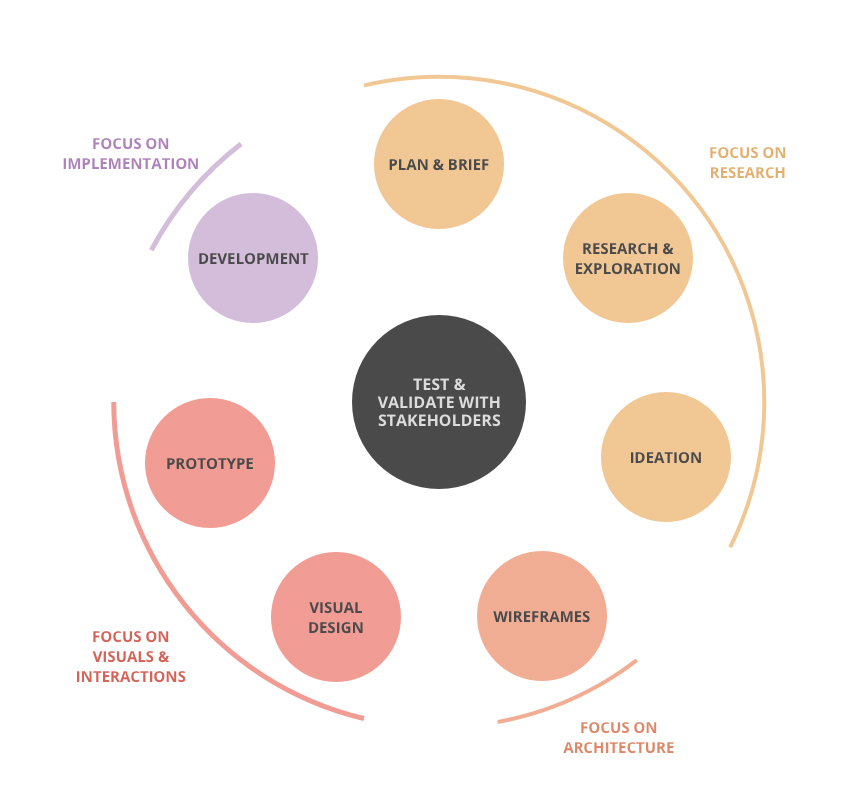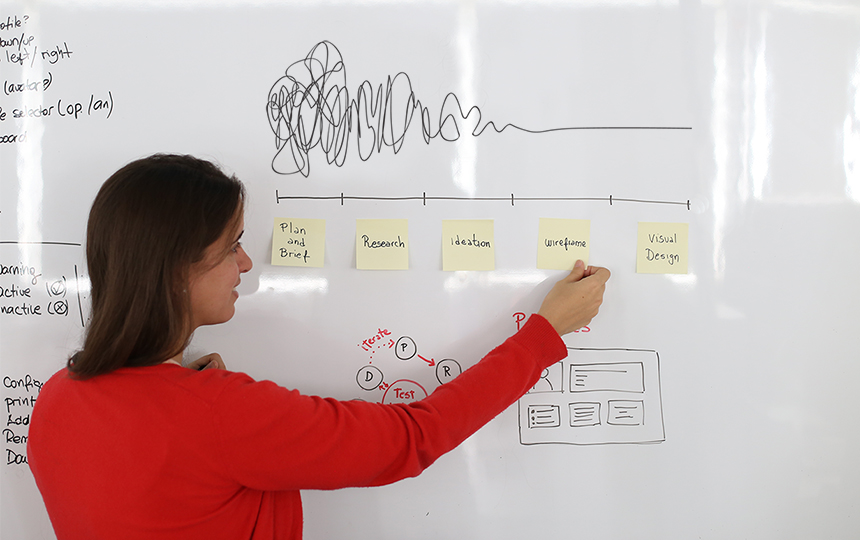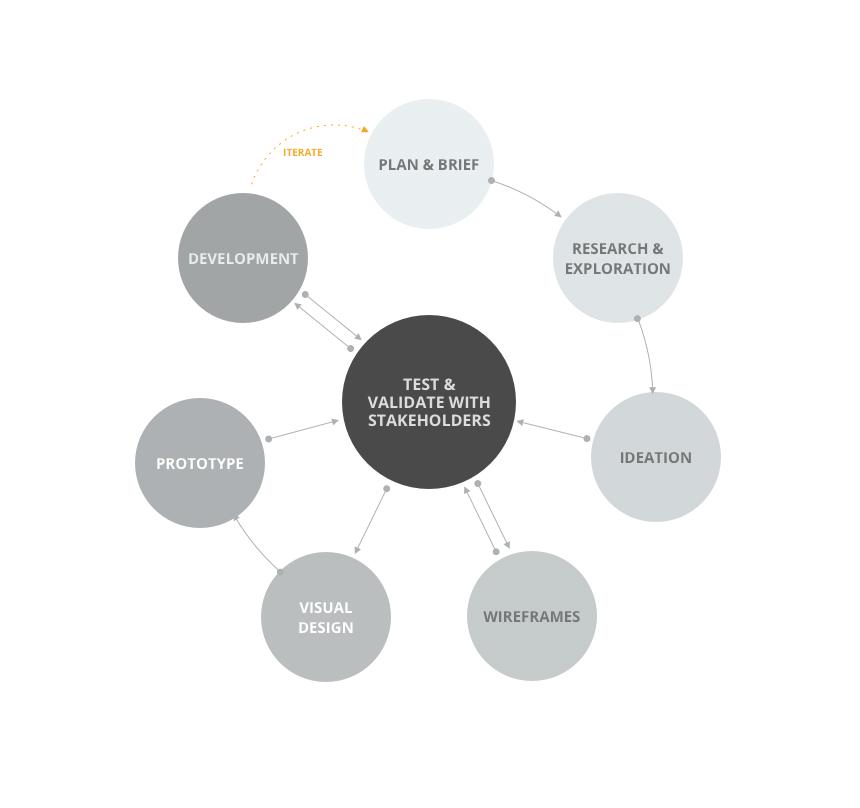User Experience Design is a production process. It has the goal of producing something real to solve a real problem, but beyond all else, it’s a service. The UX Designer is someone who provides this service for the person whom the service is delivered to. He is a professional who has to align with his partner’s vision and goals. He has to provide knowledge the partner doesn’t have, and to orient him in order to build a perfect solution for the problem the person wants to tackle, delivering a successful product.
This way of understanding the discipline as a service is not far from how we view other consultants or advisors our partner probably has on the payroll, like a lawyer, an accountant or, why not – a UX Designer.
With this in mind, developing the process that will best serve our partner is as important as developing an unique design solution. It is the art of constant enhancement: UXers constantly polish the process and, after several experiences, it becomes part of their personality as a team.
There is no secret formula to designing the perfect process. It can be explored, tested and constantly evolved to make it unique, personal and custom-based on a team’s particularities like skills, type of businesses and type of partners, among others.
Let’s briefly walk through the 4 main stages of our own UX design process: Research, Architecture, Visual & Interactions and Implementation.

Research
The UX Designer wants to know everything about you, your business and for whom you are solving problems. During this first step, Making Sense’s UX team gets deeply involved in our partner’s world.
The UX Designer starts a conversation, conducting some exploratory activities and research to better understand our partner and their needs.
The UX designer learns what sets their products or services apart from their competitors’ and listens to their ideal success story. In addition, the UX Designer detects pain points and other issues that need to be addressed through the software product. To accomplish this, he gathers and analyzes all the information that our partner may have available, such as metrics, previous tests, mission and vision statements, requirements and features, among others. This stage has 3 main processes:
- Plan & Brief
During this first step, the designer gets involved in what he will set out to achieve. He starts a conversation with the stakeholders in order to understand the problem they are trying to solve. In this first phase there are discussions about time, budget, team, expected deliverables, deadlines, phases, MVP, etc.
- Research and Exploration
The research part of the process is defined as an action where you investigate something systematically. The UX Designer applies various techniques in order to add context and insight to the design process. Research is needed to reach conclusions, establish facts, and find problems.
In addition, UX research will help the designer understand the users and their needs and identify requirements of the product. In other words, the result of the Research and Exploration Phase provides the decision maker with the information he needs: the right solution for a specific problem from a specific audience, in a given period of time.
- Ideation
Once the research is done, the UX Designer is ready to start an ideation process in order to explore, discuss and define different solutions. He detects key features as well as finds key opportunities to build a successful result. He begins moving the solution towards a tangible state, creating sketches, collaborative spaces or group discussions. The output of this phase is to clearly see the basis of the solution and to see how to creatively solve the problems.
Shaping the Architecture
The UX Designer wants to figure out the solution! At this point in the process, the team and our partner have their sights set on the same horizon, but a high-level solution is on everyone’s mind. They don’t have something tangible and visible to discuss yet, which means the “Imagination Monster” becomes part of the team, threatening the solution. It’s like the weakest point of the process right now, and the designer has to fix it.
This is the moment when the entire team gets together and the challenge begins. It’s time to solve the issues, focusing on getting the best product possible from each point of view: technical, business, project management and user experience.
Using all the information gathered from the previous phase, the wireframing process starts!
- Flows & Wireframes
After the ideation process, the goal is to put all the stakeholders and the team on the same page, reducing that imagination factor. In the ideation process UXers define a high level solution that is not tangible, which means that the shape of this solution is different within each stakeholder’s mind.
The wireframing process helps him avoid confusion and chaos that stems from people’s imagination. He conducts a low-fidelity map of the proposed solution that lets him show top-level navigation, main interactions, structures and hierarchies, among others.

Building Personality: Visuals and Interactions
Things really begin to take shape! At this point of the process, the UX Designer has peace of mind knowing that the whole team is on the same page, everyone knows the architecture of the solution, and they agree with it. The UX team is in the best position to create the most impactful piece of software possible for our partner.
- Visual Design
Once the UX Designer gets the sign-off on the structure, he starts with the aesthetic process for the solution. In this phase, he doesn’t have to be worried about navigation, flows or screens. He focuses on color palette, icons, style guidelines, hierarchies and reusable patterns. The goal of this phase is to have the final version of the solution for UX developers to start tackling the project implementation.
- Prototype
As the visual design evolves, UXers produce various kinds of prototypes as external design representations.
Prototypes give them something to evaluate before they have to commit resources to building the real product. They are constructed much faster and this makes the final product less expensive because it’s something to stand in the place of the real system to evaluate and inform the refinement of the design.
It’s one of the main techniques of our design process.
Executing the Real Experience: Implementation
Is it working? Is it really working? Execution is everything. We deeply believe that no matter how polished your process is, no matter how simple and usable your solution is, if you don’t implement it perfectly, the experience will not be perfect.
The implementation process is one of the key factors in this process of building experience. For these reasons, within our UX Process we have a UX Developer role which specialises in the implementation of user Interfaces and interactions.
The implementation of the experience covers many important aspects that need to be considered. Since this is an entire phase in and of itself, we will detail in our next post the processes and considerations to be taken into account in order to successfully move an experience from static to live.
Hey but… Where is the User?
At this point you may be asking where the user is, and the answer is simple: everywhere. In each phase of the process the UX Designer includes human beings (‘users’ sounds ambiguous at this point) in different roles and with different hierarchies. He studies them early in the project (‘studying’ them means getting involved with them), at the midpoint he validates the learnings about user needs and he validates if the solution is better than expected. Finally he starts a conversation with them about the outfit they want to wear.

Let’s Do It!
Think of the process as something similar to when you build a house. We went through the foundation process learning what we needed to know about the environment, context, the ground and everything needed to create the foundation (The Research).
Once we laid the foundation we started to build the walls, adding everything needed to build the skeleton (The Architecture). Once we all saw the skeleton and we agreed that it would work, we started the fine tuning: selecting wall colors, windows, furniture (The Visuals).
Finally, we have to live in the house (Implementation). How does it work? How does it perform? Does it maintain a consistent temperature? Is it noisy? What about the neighbors?
By identifying how big, complex, unique and disruptive your house needs to be, where the ground is, where you want to place it, and to finally understand who is going to live in the house, then we can define how long and how important each phase of this process will be for your project.
By asking all these questions, we will be able to provide a better approach, resulting in a solution that delivers value to the product we are developing. Enhancing UX and making the process easier will contribute to the success of your software product.
Shall we build your “next house together”?
